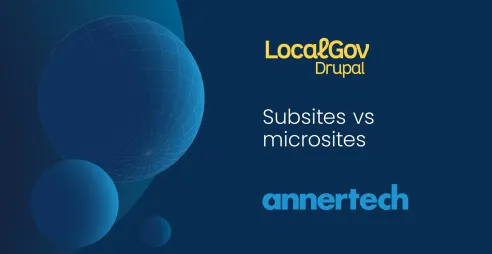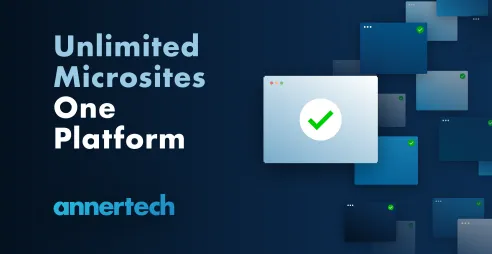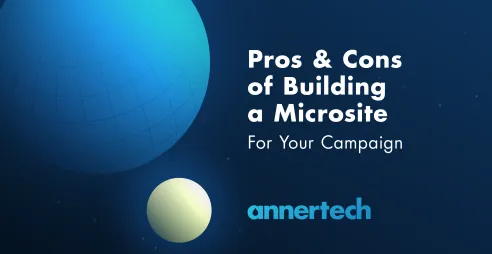Microsites FAQ: All your questions answered

Microsites are easy to set up and extremely versatile. We’ve compiled a list of the questions that we are frequently asked – from what a microsite is to the best way to manage many sites simultaneously.
We’ve also included questions that we’ve received on our service offering of the LGD Microsites platform, which gives you complete oversight of your entire digital portfolio and allows you to maintain all your microsites in one place.
General microsite questions
What is a microsite?
A microsite is an independent, focused web page or small group of pages that are designed to serve a specific purpose or audience.
I’ve heard mention of a subsite or a site section. Is this also a microsite?
No. A subsite or a site section is a part of your main website. For example, you might have a section on your website for your policies (accessibility, cookies, privacy, etc) and they might all be listed on a URL such as www.annertech.com/policies. In this case, the policies section of your website is a “section” or “subsite” of your main site.
However, if you had lots of websites you might set up a microsite for your policies and let each website link to this independent microsite. This could have a URL like policies.annertech.com. In this example, using a microsite would have the advantage of only needing to update your policies in one place in order for all your sites to be updated.
Why would I need a microsite?
Microsites are designed to serve a specific purpose or audience. If you have smaller subsidiaries or services that are part of a larger organisation, they may benefit from a microsite, rather than being a section on your main website. If you’re running a special event or if you’re launching a new product then a microsite is a great option.
Which is better, a microsite or a subsite?
This depends on your needs. This blog will help you make the right decision.
Who uses microsites and how do they use them?
Here are some examples of how microsites could be used by organisations such as marketing teams, multinationals, sporting bodies, universities, political parties and local councils.
- Marketing teams
New products, campaigns and events would all work well with their own microsites. They are built for a specific purpose, and once that purpose has been exhausted, the site can be shut down quickly and easily. It’s also easy to measure a campaign’s success, attract users to the microsite and create a unique audience for the microsite. - Multinationals
Large companies can find it challenging to run many websites simultaneously. Using microsites allows each division or branch to have its own unique domain name. The branding of the parent company can be retained while still being customised to suit the needs of the individual divisions or branches. Plus each microsite can be managed individually, with separate logins. - Sporting bodies
National sports bodies have numerous counties or provinces, and hundreds of clubs under their banner. Instead of each club in the country having their own individually developed website, microsites would offer each club the freedom of their own look and feel while still following the guidelines set out by the parent body. - Universities
Microsites allow faculties, departments and university-affiliated clubs to have their own domain name and manage their own pages, yet retain their individuality. - Political parties
The options for political parties are numerous when it comes to microsites. It would, for example, allow public representatives to have their own microsite that contains news of their particular projects, interests or areas in which they operate. The political party could have sites focusing on rallies, events, or campaigns. - City or county councils
Councils have various community events that might not have council branding. Or it could need a website for a specific service, such as elections, fostering services or recycling, for example. These events or services may be seasonal, so when the site has run its course, it can be shut down quickly and efficiently.
How many microsites could you, feasibly, have running at one time?
You could have as many as you need, providing you have the staff to maintain them.
What’s the best way to run multiple microsites simultaneously?
The LocalGov Drupal Microsites Platform was designed for this purpose. It gives you oversight of all of your microsites in one place and simplifies the entire process.
Is there a limit to the number of pages I can add to a microsite?
No. You can add as many pages as you'd like.
Questions relating to Annertech’s service offering of the LGD Microsites platform
How do I set up a microsite?
It’s quite easy to set up a microsite if you are using the LocalGov Drupal Microsite offering. We can take you through the process, help you get set up, and train you to use the platform.
What is LocalGov Drupal and how does the Microsites offering fit into it?
LocalGov Drupal, or LGD, is a CMS built by councils for councils. It was originally created as a way for local governments to offer great websites and digital experiences to their constituents by pooling their resources and saving money.
Many councils needed to be able to set up microsites, and this was when the Microsites Platform was born. It was developed by the LocalGov Drupal team.
Like LGD it is built on the open-source Drupal CMS, which means that the code is freely available.
Do I need an LGD website to use microsites?
No. The LGD Microsites Platform is a standalone product and councils are just one audience for it. Other entities such as universities could use the platform to create microsites for their departments and political parties to use it to create websites for their election candidates. These are just two examples – anyone can use the LGD Microsites Platform.
How much does a microsite cost?
Like Drupal, the LocalGov Drupal and Microsites platforms are all open source, so the code is free to use. All the functionality is there, it's the cost of the design and the content that needs to be factored in. And then when the microsite is ready to be published there will be hosting and maintenance costs to consider.
If your organisation has your own platform, you can put as many sites on it as you want at no extra charge, but if you run out of space/bandwidth, then you will need to buy more of that.
If you need support help, you could utilise the services of an agency such as Annertech, who would charge a monthly fee for supporting it. If you only have a few sites, eight hours a month might be enough. If you have lots of sites, then 16 or 24 might be necessary. But each set-up is different.
How long does it take to set up a microsite on the Microsite Platform?
Once the initial set-up is done, subsequent microsites can be set up in a matter of hours, provided all the content is ready.
How many microsites can I host on the Microsite Platform?
You can host as many sites as you want on all of our platforms. You are only restricted by the amount of disk space for files (images, video, documents, etc) on your plan and the number of visits in aggregate to your sites.
Do you manage the Drupal updates?
Yes, all updates are taken care of as part of the package price.

Do you have a question that we haven't answered in this blog?
Get in touch - we are happy to chat about a website or microsite package that will suit your needs.
Contact us


